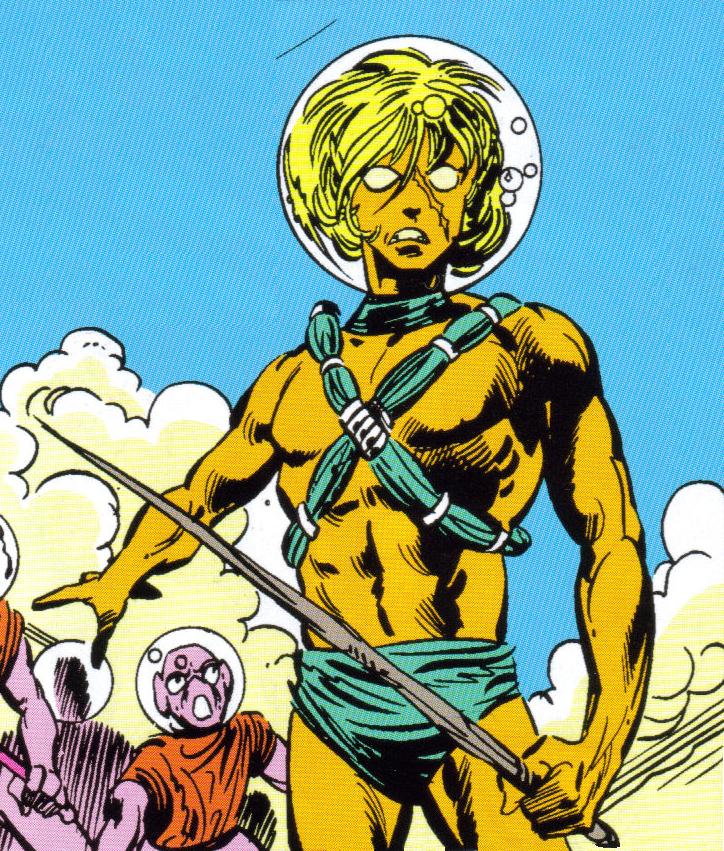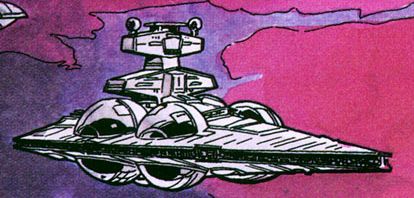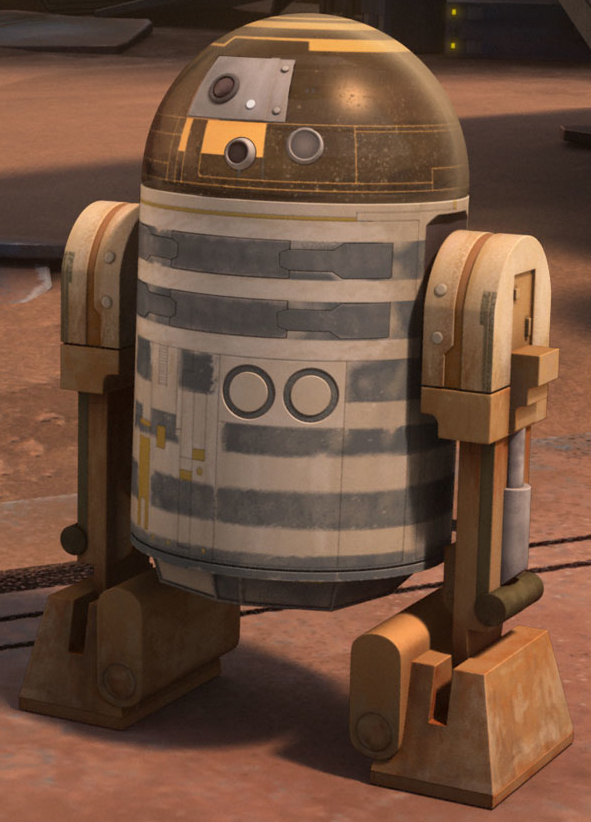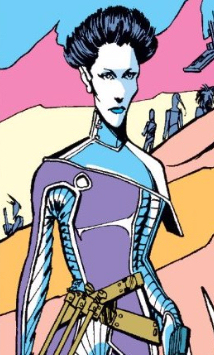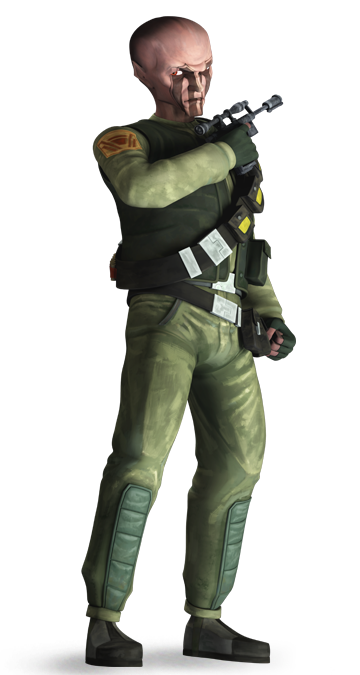 Name Sakiyan
Home Planet: Saki
Language: Sakiyan
Attribute Dice: 12D
DEXTERITY 1D+1/3D+2
KNOWLEDGE 1D/3D+1
MECHANICAL 1D/3D+2
PERCEPTION 2D+1/5D+2
STRENGTH 2D/4D+2
TECHNICAL 1D+2/3D+2
Special Abilities:
Tracking: Sakiyan have almost supernatural senses, allowing them to track targets by sound (+2D), by smell (+2D), or at night using their natural thermographic vision.
Temperature Resistant: Sakiyan are resistant to extremes in temperature, able to operate comfortably-without breaking a sweat-at heat levels that might injure non-Sakiyans, as well as frigid depths, although those were less appealing to them. This gives them +2D to resist the effects of heat and cold.
Story Factors:
Honor: Honor was exceedingly important to members of the species, and they divided it into distinct types such as monthrael-personal honor-and yithrael-pride honor. After suffering personal dishonor, a Sakiyan's family and descendants were dishonored as well. However, a family member could lift the dishonor from the clan name through glory-bringing acts.
Hunters: Sakiyan are natural hunters, and will gravitate towards careers and roles suited to these talents such as Law Enforcement or Bounty Hunting.
Move: 10/12
Average height: 1.6-2.1 meters
Skin color: Normally dark black to deep violet, red, or green, with gray, plum, bronze, jade, pale blue, and pale pink also possible
Hair color: None
Eye color: Gray, silver, blue, yellow, orange rimmed by red, red
Distinctions: Pointed ears, enhanced senses
Average lifespan: 85 standard years
Description: The Sakiyans were a humanoid sentient species whose anatomy featured slit-pupils, pointed ears, and hairless skin that varied in shade from pale to jet black. Until the rise of the Galactic Empire, xenobiologists had differing opinions as to whether Sakiyans should be classified as near-Human. However, internally, the species was vastly different from Humans and related species. The Sakiyan brain was nearly twice the size of its Human equivalent, and the portions devoted to sensory input and processing were superior even to those in the brain of the Bith species. Sakiyans had incredible vision that extended into the infrared spectrum, as well as highly acute and motion-sensitive peripheral vision. Sakiyan aural and olfactory senses were considered nearly supernatural by other species, as they allowed a Sakiyan to track and detect days-old odors and faint noises. The species' musculature granted them 150 percent of the strength of a Human of equivalent size. Sakiyan Force-users were rare.
The species evolved from predatory animals on the planet Saki in Hutt Space. Such ancestry endowed them with a love for the thrill and glory of hunting. Because of this, Sakiyans were often employed as assassins and bounty hunters. Sakiyans had a poor sense of humor and disliked being proven wrong. Honor was exceedingly important to members of the species, and they divided it into distinct types such as monthrael-personal honor-and yithrael-pride honor. After suffering personal dishonor, a Sakiyan's family and descendants were dishonored as well. However, a family member could lift the dishonor from the clan name through glory-bringing acts. Sakiyans tended to place the interests of themselves and their communities above those of others, and they were cautious in their dealings with other species, in part due to a succession of alien invasions of their homeworld. Members of the pale-skinned subspecies were treated as outcasts in Sakiyan society. Along with the Riileb, the Sakiyans were one of the few Hutt Space species to resist conquest and invasion by the Hutts. However, the Sakiyans did fall into an economic dependence on their galactic gastropod neighbors when the Hutts took controlling interests in Sakiyan technology companies that specialized in repulsorlift engineering. The Sakiyans established colonies on worlds such as Sakidopa, Sakiduba, and Sakifwanna.
Biology and appearance
Sakiyans were sentient humanoids who ranged in height from 1.6 to 2.1 meters. The species was divided into both male and female sexes, with dimorphism making the men taller than the women on average. Individuals had four or five fingers per hand, the digits capped by fingernails or claws. Each member of the species had a skeleton that included a spine and cranium; their bones contained marrow.Tendons and ligaments connected bone to muscle at angles that made Sakiyans one and a half times as strong as a Human of the equivalent size, and faster-moving as well. Ganglia of nerves lay under the flesh. Each Sakiyan also had a heart, whose pumping of blood escalated when a Sakiyan was excited, a condition detectable in the individual's pulse. At least some members of the species were ambidextrous.
Sakiyan skin was highly reflective, shining like burnished metal. Their skin tones tended to be dark, ranging from pitch black to deep violet, red, or green. However, lighter shades appeared as well, including gray, plum, bronze, jade, light blue, and pink. The pale-skinned Sakiyans constituted a separate subspecies. Sakiyan skin darkened when the individual flushed. Members of the species were resistant to extremes in temperature, able to operate comfortably-without breaking a sweat-at heat levels that might injure non-Sakiyans, as well as frigid depths, although those were less appealing to them. Sakiyans were able to use synthflesh to heal wounded tissue. They were vulnerable to the effects of dendriton toxin.
The shiny, hairless Sakiyan pate left visible both subcutaneous veins and the bifurcated cranium below, which was larger than that of a Human. The expressive visage was characterized by two eyes, a nose, and a mouth with two ears on the sides. In some Sakiyans, the ears were pointed, although those points were less pronounced in some members of the species and completely absent in others. Facial structure varied such that some Sakiyans had prominent jowls while others had svelte cheeks. Sakiyan eyes resembled those of Humans except that, whereas Human visual organs shrank to round pupils, the Sakiyans' narrowed to slits. Eye color varied less than that of Humans, with white, gray, silver, blue, yellow, and orange rimmed by red obtaining. In other specimens, the eye color changed depending on the lighting: one example had a red sclera, with irises that ranged from yellow to blue or green. Sinuses lay behind the nose, and those cavities were susceptible to burning from certain foods, such as ganno juice. Sakiyans sported fangs among their white teeth, which sprouted from pink gums. The depths of the Sakiyan throat could produce a low, rumbling noise, almost subsonic in nature, and at least some members of the species had a gruff voice.
Because their appearance was so similar to that of the Human species, xenobiologists debated whether to classify the Sakiyans as a near-Human species or one completely unrelated. Those scientists who argued for the latter status cited the species' vastly different brain structure as their strongest evidence. The brain was nearly double the size of its Human counterpart, a result of the organ's highly developed centers devoted to sensory input and reflexes. Indeed, the Sakiyans reached nearly supernatural levels of sensory perception, surpassing even the large-brained Bith in perceptual capabilities. Sakiyans enjoyed excellent visual acuity, with sight extending into the infrared range and with keen peripheral vision. Infrared light appeared as a silver glow to Sakiyan eyes, and their capability at detecting it allowed members of the species to even see through walls if adequate heat sources lay on the opposite side. The wide variety of wavelengths to which their eyes were attuned made full-spectrum light seem almost like a glare to a Sakiyan, even to the point of proving bothersome and bringing tears to the eyes. The species' hearing was also well developed, acute enough to detect a creature as tiny as a gravel-maggot burrowing through the soil. They enjoyed discriminatory smell, keen enough to track prey; a skilled Sakiyan hunter could smell the slightest trace of quarry, down to the smell of its sweat or the after-odor of a recent blaster fight, and with a good whiff, a Sakiyan could detect a quarry's species and age. In sum, the Sakiyan brain, evolved over centuries, gave them the senses and reflexes to be natural-born hunters.
Sakiyans entered adolescence at age 11 and reached full adulthood at age 16. They entered middle age at 49 and had a life expectancy of 85 standard years. In advanced age, various Sakiyans suffered from dulled senses, with some even going deaf. Possible physiological reactions to dying included trembling and inability to focus the eyes. Some members of the species exhibited sensitivity to the Force, but the trait was generally rare among the Sakiyan population.
Society and culture
Sakiyan family structure separated the species into groups known as prides or clans. Each Sakiyan recognized an individual known as a pride-father, and other individuals were known as pride elders. The Sakiyans had highly developed concepts of honor that dictated how to respectfully treat others. Honor came in many varieties, each with its own distinct name and rules. Monthrael was a Sakiyan's personal honor, thought to also control the individual's destiny. Yithrael-pride or clan honor-was held in particularly high esteem. In the case of a clan's reputation being besmirched, the members might go to great length to redeem their collective honor; indeed, piquing a Sakiyan's honor even caused physiological response, such as a racing pulse. Obtaining large amounts of land or wealth was one means to do so. Sakiyan males were expected to provide for their families lest their personal and pride honor be diminished. Sakiyans wed to a mate, while the children were referred to as younglings. Dying with a mark against one's honor was considered the cruelest fate that could befall a member of the species. Sakiyans recognized special expanses called bonepits; seeing an avian scavenger known as a flensor fly over one's bonepit was considered an ill-omen. In Sakiyan religion, the afterlife was known as the Realm Beyond.
Clans were organized into convoluted family–political units. On their homeworld of Saki, also known as Sakiya, these manifested as communities headed by selected leaders. The Sakiyans were a wary people who valued the survival and safety of their own community above those of others. Coupled with a natural territoriality, especially when other hunters encroached on their domain, they were cautious around outsiders-especially non-Sakiyans. Their mantra was "survival demands efficiency." Indeed, each settlement developed a detailed plan to enact in the event that an outside force attacked or attempted a conquest. To that end, communities maintained underground escape routes known as warrens. Lightweight repulsorlift platforms lay in wait to evacuate children, the infirm, and important leaders, as well as to carry away important equipment and supplies in case of such danger. The Sakiyans were no pacifists, though: standing armies responded to invading forces with tactics of harassment and retreat. Most invading forces gave up in the face of such resistance. In a worst-case scenario, a Sakiyan had no compunction about eating other sentients, especially if family survival depended on such a decision. Despite the wide variety of skin tones evident in the species, the Sakiyans ostracized their pale-skinned members as aberrations.
Hunting was highly valued in Sakiyan society. While many Sakiyans practiced hunting on their homeworld, the species considered themselves self-assured predators in a galaxy replete with grass-eaters and only a few other predatory species worthy of Sakiyan respect. They used not only their senses but also cunning, planning, and patience to capture prey; for instance, when hunting for gwayo bird eggs on Saki, the hunter stalked the bird until led to its nest. Sakiyan hunters trained themselves to slow their heart rate and calm themselves; such measures allowed the individual to move with greater speed. Sakiyans also hunted for sport, with the more dangerous the quarry and the more perilous the hunt, the more honorable and satisfying it was to the hunter.
Saki was a planet abuzz with industrial activity, and Sakiyan technology was on par with other spacefaring species. An intelligent and hardy people, they particularly excelled at repulsorlift technology, with particular emphasis on the engineering of components to be lighter and more efficient. For that reason, Sakiyan repulsorlift technology was highly sought after by the Hutts, which led the gastropod species to commission Sakiyan-designed repulsorsleds in ever more dainty and elaborate models. Hutt interests in Sakiyan repulsorlift engineering were so great that the Hutts virtually controlled the market, placing the Sakiyans into an ineluctable financial relationship with their galactic neighbors. A variety of Sakiyan flute made a noise that members of the species found pleasant; the sound resembled a member of the Ghostling species sighing.
At least some Sakiyans viewed other species as inferior due to their underdeveloped senses; in comparison to the Sakiyans, the belief went, other species could only hope to flail about in near blindness, lacking as they were in the ability to see into the infrared. Still, some non-Sakiyans entered the tutelage of a Sakiyan hunter to improve their own hunting skills; the Nimbanel Tawss Khaa was one example. Because full-spectrum light bothered them, Sakiyans in the galaxy at large coped by wearing dark visors in bright light or dimming room lighting to avoid glare. Typical Sakiyan clothing included elaborate robes or full-body jumpsuits. At least some Sakiyans sported facial markings. Sakiyans disliked being doubted and even less being shown to be wrong. They were not entirely fearless; for instance, one Sakiyan joined a Ryn and a Sanyassan in keeping a safe distance from a Sarkan.
Sakiyans expressed emotion through their faces; a frown indicated discomfort, while a smile indicated pleasure. Although able to laugh, Sakiyans were not known for their well-developed senses of humor. Raising two hands and shaking the head conveyed that the Sakiyan recognized his or her interlocutor's attempt at trickery, while rolling the eyes indicated annoyance. Another gesture was to snap fingers when struck by an idea, and to shrug to indicate disinterest or self-deprecation. A snort indicated derision, while a growl denoted anger. Anticipation might cause a Sakiyan to tremble. Their native language was also known as Sakiyan, which the typical member of the species could both speak and write. They could also speak Basic, and many learned Huttese as well. Sakiyan names consisted of two parts, a clan name followed by a personal name; for instance, the Sakiyans Tarnese Bleyd and Tarnese Lyanne both came from Clan Tarnese. Other examples of names included Ejaf Ya-Drun, Johr Penyk, Djas Puhr, Kol Rzad, Tudan Sal, Moja Skunaz, and Vihn Thas. The clan name doubled as a Sakiyan's personal blood cry.
History
The tropical world of Saki, in orbit around the star Saki Prime, served as the backdrop for the evolution of the Sakiyan species. The planet's little seasonal variation gave rise to wide swaths of jungles, swamps, and veldts punctuated by savannas and lakes. The species' ancestors were prey animals who dwelt in trees and atop natural high points. As a response to the dangerous predators of their world, the early Sakiyans evolved advanced senses as a survival mechanism. Eventually, the Sakiyans themselves developed into a species of successful hunters, their senses honed to track prey, and sporting dark skin to camouflage them against the backdrop of their homeworld. Based on their highly developed brains, xenobiologists postulated that the earliest Sakiyans arose far back in the galactic past. As the species developed the capacity to use tools and create their own shelter, they maintained their advanced senses, unlike countless other species. Meanwhile, generations spent as hunters made the Sakiyans tough and durable.
From at least 25,000 BBY, the Sakiyans faced numerous invasions by offworlders intent on conquering their planet. Due to their homeworld's location in Bootana Hutta, close to Hutt Space's astrographical center, the species came into contact with the Hutts in the distant past. Indeed, Sakiyan records were some of the oldest to chronicle the early spacefaring civilization of the Hutts, telling of "Hutt cavaliers" in armor-sometimes speculated to have been precursors to the Shell Hutts-and recording Sakiyan tribute sent to the Hutts, including technological expertise in the form of help with developing planechanga, enormous railguns able to propel boulders through space at such speeds that they could crack a planet upon impact. The Sakiyans were careful to keep the Hutts at a distance in all aspects of life on Saki save commerce; in this way, the Hutts were wooed into settling for economic domain over Saki and its denizens rather than outright political control, a feat only bested by the Riileb of the planet Riileb, who evaded even economic control by the Hutts. The arrangement allowed the Sakiyans to avoid becoming a slave species, as was the fate of most other non-Hutt natives of Hutt Space-although at least one Sakiyan did serve the Hutts in some capacity. Instead the Sakiyans remained independent and respected by their Hutt neighbors. Relations remained fraught between the two species for millennia, with the Sakiyans referring to their neighbors as "slugs."
Other invasion attempts were made by the Tion Hegemony, the Sith, and the Drackmarians. As the Tionese expanded under the reign of Xim the Despot, the Sakiyans had already established their relationship with the Hutts. When the Tionese encountered Sakiyan and Nimbanese traders who claimed to serve the Hutts, Xim's curiosity was piqued, prompting his war with the Hutts. The Sakiyan homeworld later fell within the bounds of Sith Space from 1004 to 1000 BBY, during the New Sith Wars. Xenobiologists postulated that as a result of those hostile encounters with outsiders, the Sakiyans developed their propensity for caution and mobility in their communities.
At some point, the Sakiyans received peaceful visitors from the Galactic Republic, scouts, who shared with the species the secrets of repulsorlift technology. The Sakiyans recognized the possibilities that repulsorlift afforded them in their efforts to remain deft and mobile, and their engineers tweaked the technology to emphasize those attributes. Their efforts came to the attention of the Hutts, who soon established their economic dominance over the Sakiyan repulsorlift industry. The Sakiyans were represented in the Galactic Republic by senators. They eventually founded three colony worlds, Sakidopa, Sakiduba, and Sakifwanna, each located in a star system of the same name.
After the rise of the Galactic Empire in 19 BBY, the Sakiyan homeworld's location in the bowels of Hutt Space kept the species insulated from the grasp of Emperor Palpatine and his forces. However, the Empire abducted Sakiyan technicians and forced them to work in Imperial research and development centers to improve the Empire's repulsorlift technology, particularly in the development of new repulsortanks. During that period, xenobiologists finally settled the debate over whether to classify the Sakiyans as near-Humans or non-Human, coming to the consensus that the Sakiyans were non-Human based both on their appearance and the vast differences in their brain structure.
With the fall of the Empire and the rise of the New Republic in 4 ABY, both that new government and the Hapans of the Hapes Consortium approached the Sakiyans to broker political and commercial alliances. Nevertheless, the Sakiyans remained wary, telling the outsiders to speak to the Hutts instead. After the species known as the Yuuzhan Vong made their first advance on Hutt Space in 26 ABY during their invasion of the galaxy, they spared the Saki system. The unorthodox tactics of the alien invaders worried the Sakiyan leadership that the outsiders might be able to circumvent the Sakiyans' battle-tested strategies to resist invasion. They thus began to make furtive overtures of support to the New Republic and the Hapans in the case those groups decided to counterattack the Yuuzhan Vong. After the Yuuzhan Vong devastated Hutt Space, the fate of the Sakiyans remained unknown to the rest of the galaxy. By circa 25 ABY, the population of the Saki system was between 100 to 500 million inhabitants.
|









